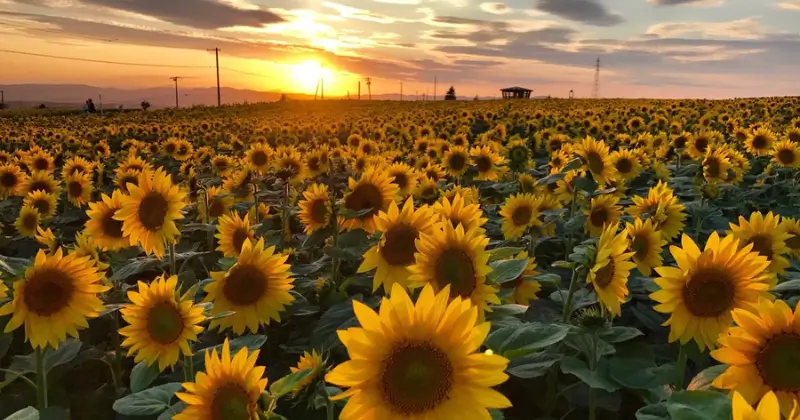A sunflower circle is a beautiful and functional addition to any backyard, providing a vibrant display of golden blooms while creating a peaceful outdoor retreat. Learning how to build a sunflower circle is simple, and with the right approach, you can design a breathtaking natural sanctuary. This guide will take you through each step, from selecting the best sunflower varieties to maintaining your stunning floral haven.
Why Build a Sunflower Circle?
Sunflowers are not only aesthetically pleasing but also beneficial to your garden’s ecosystem. Here’s why you should consider building a sunflower circle:
- Attracts pollinators: Bees, butterflies, and birds love sunflowers, enhancing biodiversity.
- Provides shade and privacy: Tall sunflower varieties create a cozy, enclosed space.
- Easy to grow: Sunflowers are resilient and require minimal maintenance.
- Great for kids: This project can be a fun, educational activity for children.
Step 1: Choosing the Right Location
The success of your sunflower circle depends on selecting an optimal location. Sunflowers thrive in full sun, needing at least six to eight hours of direct sunlight daily. Choose a spacious, open area in your backyard with well-draining soil. Avoid shaded spots near large trees or buildings that may block sunlight.
Step 2: Selecting the Best Sunflower Varieties
Different sunflower varieties vary in height, bloom size, and growing conditions. Consider these options:
- Tall varieties (6-12 feet): Russian Mammoth, Skyscraper, American Giant – ideal for creating an enclosed space.
- Medium-height varieties (4-6 feet): Autumn Beauty, Lemon Queen – offer a mix of colors.
- Dwarf varieties (1-3 feet): Teddy Bear, Suntastic Yellow – great for adding depth and texture.
Mixing varieties can create a visually dynamic and stunning sunflower circle.

Step 3: Designing Your Sunflower Circle
To create a perfectly shaped sunflower circle:
- Mark the area: Use a rope or garden hose to outline the circle’s perimeter.
- Measure the diameter: A 6 to 10-foot diameter is ideal for a cozy seating space.
- Decide on an entrance: Leave a small gap in the planting area for easy access.
Step 4: Preparing the Soil
Healthy soil ensures strong, tall sunflowers. Follow these steps:
- Loosen the soil: Use a garden fork or tiller to break up compacted ground.
- Enrich with compost: Mix in organic compost for nutrients.
- Check soil pH: Sunflowers prefer a slightly acidic to neutral pH (6.0-7.5).
Step 5: Planting Sunflowers
Once your soil is prepared, it’s time to plant.
- Sow seeds directly: Sunflowers dislike being transplanted, so plant seeds directly in the ground.
- Spacing: Place seeds 6-12 inches apart for tall varieties and 12-18 inches apart for smaller ones.
- Depth: Plant seeds about 1 inch deep.
- Watering: Keep the soil moist until germination occurs (usually 7-10 days).
Step 6: Caring for Your Sunflower Circle
Maintaining your sunflower circle ensures healthy growth.
- Water regularly: Sunflowers need deep watering about once a week.
- Fertilize moderately: Use a balanced fertilizer to encourage robust growth.
- Support tall varieties: Install stakes for extra stability in windy areas.
- Control weeds: Apply mulch to retain moisture and suppress weed growth.
Step 7: Enhancing Your Sunflower Circle
Make your sunflower circle even more inviting by incorporating additional elements:
- Seating: Place a bench or chairs for relaxation.
- Pathway: Add stepping stones leading to the entrance.
- Companion plants: Grow marigolds or zinnias to attract pollinators and add more color.
Step 8: Enjoying and Harvesting Sunflowers
Your sunflower circle will reach full bloom in late summer. Enjoy its beauty, and consider harvesting seeds:
- For replanting: Allow flowers to dry on the stem, then collect mature seeds.
- For snacking: Roast and season sunflower seeds for a healthy treat.
- For wildlife: Leave some seed heads for birds to enjoy.
For more gardening tips and insights, discover our articles
FAQs
1. How long does it take for a sunflower circle to bloom?
Sunflowers typically bloom 70-100 days after planting, depending on the variety.
2. Can I grow a sunflower circle in a small backyard?
Yes! Adjust the circle’s size and use dwarf sunflower varieties for a compact yet stunning design.
3. Do sunflowers come back every year?
Annual sunflowers bloom once per season, while perennial varieties return yearly. Collect seeds from annuals to replant the next season.
Conclusion
Building a sunflower circle in your backyard is a rewarding and visually stunning gardening project.
By following these step-by-step instructions, you’ll create a thriving natural retreat that enhances your outdoor space. Start planting today and transform your backyard into a sunflower paradise.
By implementing these tips, your sunflower circle will flourish, bringing beauty and biodiversity to your garden. Happy gardening!
